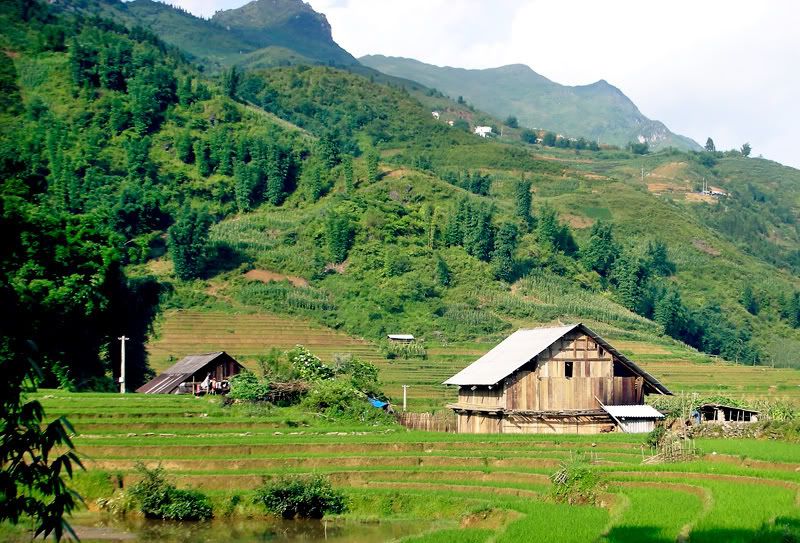A very long time
ago, Lac Long Quan – the dragon king from the sea and Au Co – the immortal
fairy who lived high in the mountains met, fell in love and got married. On the day of giving birth, Au Co bore an egg
sac from which hatched 100 children who grew up quickly and became as strong as
their father and as kindhearted as their mother. Despite their love, Lac Long
Quan and Au Co became unhappy. The dragon king yearned for the sea while the
mountain fairy always found her heart longing for the highlands. They decided
to part and divide their children, of whom fifty would dwell with Au Co in the mountains.
Lac Long Quan would lead the other fifty to live along the coasts. They made a
promise that despite distance and separation, they will always look after each
other and lend a hand should one be in need.
Source : Lac Long Quan and Au Co dividing their children
The children of
Lac Long Quan and Au Co are, according to this myth, believed to be the
ancestors of all Vietnamese ethnic groups. The fifty children that went with Au
Co are called “highlanders” while the other fifty led by Lac Long Quan are
called “lowlanders.” The legend has become the pride of Vietnamese people as it
implies an unbreakable bond of unity for all Vietnamese. When Ho Chi Minh, the
nationalist revolutionary leader of Vietnam, returned to his home country after
30 years being abroad, he wrote a poem that likened Lenin to a river and Marx
to a mountain waiting to be “united in the same country” (Vietnamese: Kia suối
Lê-nin, đây núi Mác/Hai tay dựng một sơn hà). The road to communism, for Ho Chi
Minh, seemed to go from nationalism as he brought home a complex and alien
ideology by linking the fathers of communism to a familiar Vietnamese mythical
theme – the unification of mountains and rivers from Lac Long Quan – Au Co
legend. This recurring theme of “national unity” appeared even more during the Vietnam
War when the country was divided in two: North Vietnam backed by the Soviet
Union and communist allies and South Vietnam backed by the United States and
other anti-communist allies. Lowlanders or highlanders, bounded by their shared
identity as “descendants from the Dragon and Fairy,” were ready to fight for a
united Vietnam.
However, after
the Vietnam War, the split between lowlanders (dominated by an ethnic
Vietnamese elite: Kinh people, accounted for 86.2% of Vietnamese) and
highlanders (mostly ethnic minorities) became larger. It is not just a
geographical division but also a cultural and economic split. The living
conditions in the highlands lag behind those in the lowlands, in part
because many highlanders live in remote areas and are generally disconnected
from the economy. Highlanders also have higher illiteracy and school drop-out
rates than the ethnic Kinh majority, some of whom tend to treat the highlanders
as an underclass. In the lowlands, highland ethnic minorities are seen by a lot
of people as superstitious, backward and primitive while their “slash-and-burn”
agricultural practices are regarded as the main cause for the rapid
deforestation. Minorities are insufficiently represented in the government; the
elevation of Nong Duc Manh (an ethnic Tay) to the position of General Secretary
of the Communist Party is an exception. Most highlanders do not speak
Vietnamese and have customs of their own. The distance between the highlands
and lowlands only contributes to the persistence of societal discrimination
against ethnic minorities.
Source: Highlands
Source (me): Lowlands (Hanoi)
As a
consequence, many ethnic groups feel that they are being repressed, and ethnic
minority activists started to emerge. Nevertheless, all these protests quieted
down when the government arrested the leaders on charges of “causing public
disorder” and “undermining the unity policy.” The problem of ethnic minorities,
along with Vietnamese fear of Chinese encroachment in South China Sea, has always been
central to Vietnamese national-security policy. For many years, the government
has tried to address this problem by developing plans to strengthen national solidarity
such as population redistribution and political integration. I personally think
the gap between two communities has been generally narrowed as a result of government
policy to acknowledge and celebrate cultural diversity. Customs and languages
of highlanders appear more and more on television, in music and in our
textbooks. Nevertheless, most of what I’ve learned in high school about
highlanders were through stories of them fighting alongside lowlanders against
foreign invasion to gain the right to national self-determination. In all of
these stories, the state border is always the most important and relevant
dividing line as lowland and highland ethnic groups are united within the frame
of the Vietnamese nation.



A great story of how social and historic circumstance creates a group of "others" despite common roots. It's interesting that despite the government's repression of ethnic minorities they simultaneously take initiatives to celebrate cultural diversity.
ReplyDelete